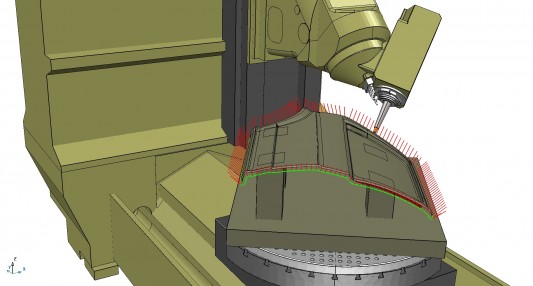The update promises smoother results and greater control on complicated curves, with the additional ability to increase point density in specified areas.
Delcam has released the 2012 version of its PowerMILL CAM system for high-speed and five-axis machining. The new release includes a number of new strategies, together with more general enhancements to make programming faster and machining more efficient with the best-possible surface finish.

Delcam considers flowline machining the “most important” new option in this release. The toolpath is divided between a pair of drive curves in a constant number of passes, rather than having a varying number of passes with a constant stepover. The toolpath will have its start and end passes on the drive curves, with the intermediate passes blending between them. Delcam says this approach gives smoother results becaue it ensures each pass travels over the full length of the area, rather than leaving the part or making major changes in direction during the pass. Delcam also says it produces a better surface finish on the part and minimizes wear on the cutter and the machine tool.
Flowline machining can be applied across part of a surface, across a complete single surface or across multiple surfaces. Intermediate curves may be added between the boundaries of the area to give even greater control over the toolpaths. These might be needed for particularly complex fillets or when machining gently-curved surfaces to a smooth finish.
Also new in PowerMILL 2012 is the ability to control the angular point distribution during five-axis machining. This option can be used to keep the machine tool moving smoothly when there is rapid angular change in one of the rotary axes of the machine tool. The problem occurs mainly when moving around sharp corners but is also important when the machine is operating near a vertical tool axis. If the machine tool is near the gimbal lock position, small movements in the tool-axis vector can result in large movements in one of the axes.
In both examples, Delcam says smoother tool-axis changes can be achieved by increasing the density of the points in these areas. The user can specify the maximum angle that the tool axis can move between points. Extra points are inserted automatically to ensure the specified maximum angle is not exceeded. The result is more even movement of the machine and a better surface finish, with no risk of dwell marks. The smoother motion also reduces wear on the machine.
PowerMILL has offered an optional module for automated machining of blades, blisks and impellors for some time. This module has now been enhanced with the addition of a spiral machining strategy. This keeps the cutter on the surface of the part for the complete operation and so gives more even tool loading and a better surface finish.
A more general enhancement is the ability to use Bezier curves rather than polylines when sketching geometry in PowerMILL. Bezier curves give smoother boundaries, patterns and drive curves, and so enable better quality toolpaths to be produced.
Other enhancements in PowerMILL 2012 include more control over the clearance distances applied to the cutter and its holder. This is especially desirable when machining near-vertical faces, as a smaller clearance can be set for the shank, while still allowing a larger clearance for the holder. It allows the shortest safe cutter to be chosen, with no risk of collisions. Using shorter cutters will usually allow faster machining and minimise chatter so giving a better surface finish.
In addition, thread milling options have been added, and workplane editing, and Z-height selection and limiting, have been made easier. It has also been made easier to obtain measurements, including distances, angles and directions, from the part model and enter these values into forms automatically. Finally, the use of the PowerMILL macro language to program repeat operations has been extended to give users more options to customise the system for their particular needs.





